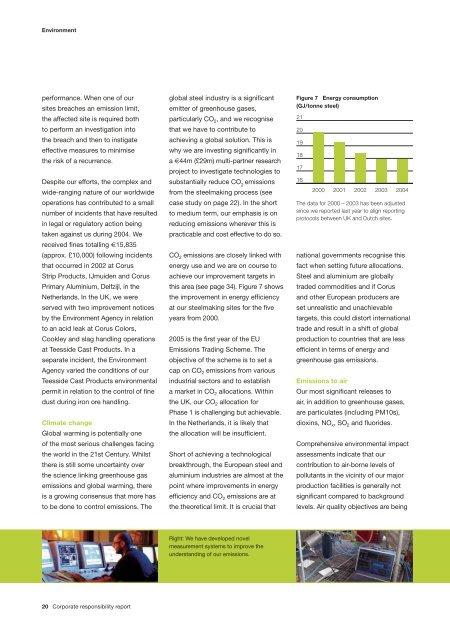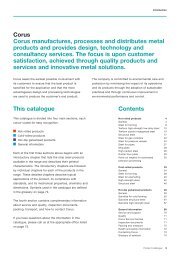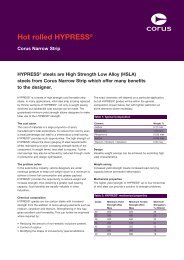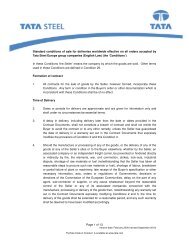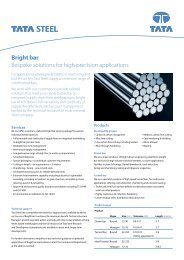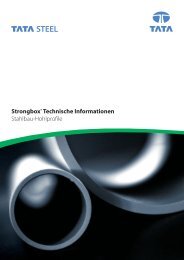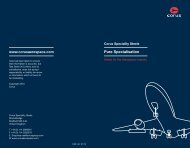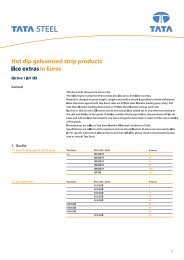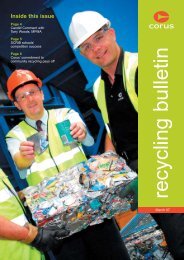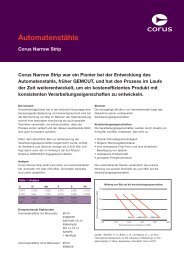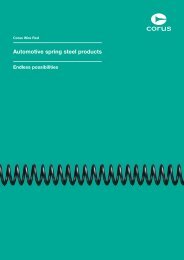Corporate responsibility report 2004 - Tata Steel
Corporate responsibility report 2004 - Tata Steel
Corporate responsibility report 2004 - Tata Steel
You also want an ePaper? Increase the reach of your titles
YUMPU automatically turns print PDFs into web optimized ePapers that Google loves.
Environment<br />
performance. When one of our<br />
sites breaches an emission limit,<br />
the affected site is required both<br />
to perform an investigation into<br />
the breach and then to instigate<br />
effective measures to minimise<br />
the risk of a recurrence.<br />
Despite our efforts, the complex and<br />
wide-ranging nature of our worldwide<br />
operations has contributed to a small<br />
number of incidents that have resulted<br />
in legal or regulatory action being<br />
taken against us during <strong>2004</strong>. We<br />
received fines totalling €15,835<br />
(approx. £10,000) following incidents<br />
that occurred in 2002 at Corus<br />
Strip Products, IJmuiden and Corus<br />
Primary Aluminium, Delfzijl, in the<br />
Netherlands. In the UK, we were<br />
served with two improvement notices<br />
by the Environment Agency in relation<br />
to an acid leak at Corus Colors,<br />
Cookley and slag handling operations<br />
at Teesside Cast Products. In a<br />
separate incident, the Environment<br />
Agency varied the conditions of our<br />
Teesside Cast Products environmental<br />
permit in relation to the control of fine<br />
dust during iron ore handling.<br />
Climate change<br />
Global warming is potentially one<br />
of the most serious challenges facing<br />
the world in the 21st Century. Whilst<br />
there is still some uncertainty over<br />
the science linking greenhouse gas<br />
emissions and global warming, there<br />
is a growing consensus that more has<br />
to be done to control emissions. The<br />
global steel industry is a significant<br />
emitter of greenhouse gases,<br />
particularly CO 2 , and we recognise<br />
that we have to contribute to<br />
achieving a global solution. This is<br />
why we are investing significantly in<br />
a €44m (£29m) multi-partner research<br />
project to investigate technologies to<br />
substantially reduce CO 2<br />
emissions<br />
from the steelmaking process (see<br />
case study on page 22). In the short<br />
to medium term, our emphasis is on<br />
reducing emissions wherever this is<br />
practicable and cost effective to do so.<br />
CO 2 emissions are closely linked with<br />
energy use and we are on course to<br />
achieve our improvement targets in<br />
this area (see page 34). Figure 7 shows<br />
the improvement in energy efficiency<br />
at our steelmaking sites for the five<br />
years from 2000.<br />
2005 is the first year of the EU<br />
Emissions Trading Scheme. The<br />
objective of the scheme is to set a<br />
cap on CO 2 emissions from various<br />
industrial sectors and to establish<br />
a market in CO 2 allocations. Within<br />
the UK, our CO 2 allocation for<br />
Phase 1 is challenging but achievable.<br />
In the Netherlands, it is likely that<br />
the allocation will be insufficient.<br />
Short of achieving a technological<br />
breakthrough, the European steel and<br />
aluminium industries are almost at the<br />
point where improvements in energy<br />
efficiency and CO 2 emissions are at<br />
the theoretical limit. It is crucial that<br />
Figure 7 Energy consumption<br />
(GJ/tonne steel)<br />
21<br />
20<br />
19<br />
18<br />
17<br />
16<br />
2000 2001 2002 2003 <strong>2004</strong><br />
The data for 2000 – 2003 has been adjusted<br />
since we <strong>report</strong>ed last year to align <strong>report</strong>ing<br />
protocols between UK and Dutch sites.<br />
national governments recognise this<br />
fact when setting future allocations.<br />
<strong>Steel</strong> and aluminium are globally<br />
traded commodities and if Corus<br />
and other European producers are<br />
set unrealistic and unachievable<br />
targets, this could distort international<br />
trade and result in a shift of global<br />
production to countries that are less<br />
efficient in terms of energy and<br />
greenhouse gas emissions.<br />
Emissions to air<br />
Our most significant releases to<br />
air, in addition to greenhouse gases,<br />
are particulates (including PM10s),<br />
dioxins, NO x , SO 2 and fluorides.<br />
Comprehensive environmental impact<br />
assessments indicate that our<br />
contribution to air-borne levels of<br />
pollutants in the vicinity of our major<br />
production facilities is generally not<br />
significant compared to background<br />
levels. Air quality objectives are being<br />
Right: We have developed novel<br />
measurement systems to improve the<br />
understanding of our emissions.<br />
20 <strong>Corporate</strong> <strong>responsibility</strong> <strong>report</strong>


